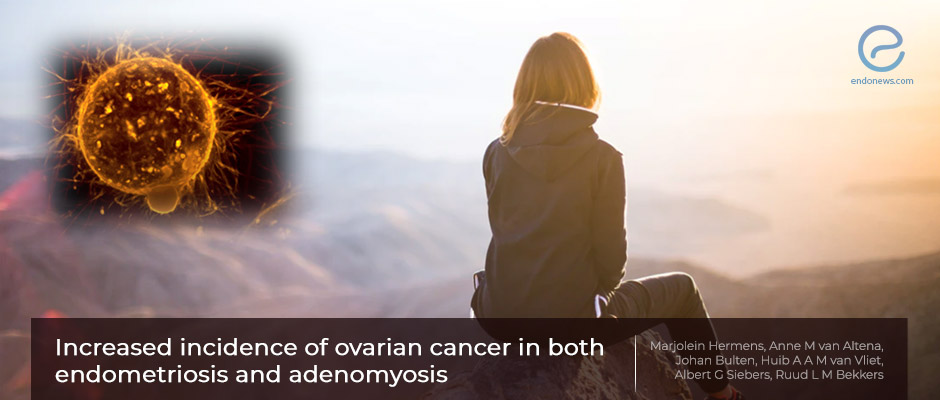Ovarian cancer risk in endometriosis and adenomyosis
Oct 26, 2021
The risk of ovarian cancer is increased not only in endometriosis, but also in adenomyosis, study suggests
Key Points
Highlight
- Endometriosis and adenomyosis patients are both at risk for developing ovarian cancer, particularly clear-cell and endometrioid type ovarian carcinoma.
Importance
- Gynecologists should be aware of the potential risk of ovarian cancer when treating adenomyosis patients.
Key results
- There are many studies assessing the ovarian cancer risk in patients with endometriosis however, this is the largest study that also evaluates adenomyosis patients.
- Ovarian cancer risk is found to be 2.0% and 1.5% for endometriosis and adenomyosis patients, respectively.
- Ovarian cancer was seen at a significantly younger age in endometriosis patients.
- The age-adjusted incidence rate ratios over time showed an increased risk of clear-cell and endometrioid ovarian carcinoma in both groups.
- The risk of ovarian carcinoma was higher in patients with endometriosis.
What’s done here?
- This is a large population-based database study assessing the risk of ovarian cancer development in women with histologically proven endometriosis and adenomyosis.
- More than 130.000 women with endometriosis and adenomyosis were compared with the same number of women with a dermal nevus.
Strengths and Limitations:
- Including only histologically proven cases, the large nationwide database, and is the first study to assess adenomyosis in terms of ovarian cancer risk are strengths.
- The lack of clinical factors, the lack of the re-assessment of the cases, and the lack of knowledge of whether the nevus patients in the control group had underlying non-diagnosed endometriosis or adenomyosis are the limitations.
Lay Summary
Through the historical development of the nomenclature for endometriotic tissue found inside and/or outside the uterus, many terminologies have been used. The accepted terminology is still the one introduced by Sampson: “Endometriosis”. “Adenomyosis” also known as “endometriosis interna” which is the presence of endometrial glands and stroma in the myometrial tissue, was later described as a separate entity. Even though the latest research has been mostly about endometriosis, there is an increasing focus on adenomyosis as well.
It has been shown by many studies that endometriosis causes an increase in the risk of ovarian cancer. Hermes et al. from the Netherlands published a population-based database study in 2020 where they reported an increased ovarian cancer risk in patients with endometriosis. However, given the fact that the risk in adenomyosis alone has not been shown thoroughly and the results have been discordant previously, they stratified the histologically proven cases of endometriosis into subgroups (endometriosis, adenomyosis, endosalpingiosis, and endocervicitis) and performed a new study which was published in the July 2021 issue of the journal Gynecologic Oncology.
Ovarian cancer cases constituted 2.0% of the patients with endometriosis whereas it was detected in 1.5% of adenomyosis patients. Ovarian cancer in endometriosis patients was seen significantly earlier compared to the adenomyosis patients and the authors explained this finding with the early onset of endometriosis in the patients which causes a longer exposure. When the authors analyzed the age-adjusted incidence rates over time, they found that clear-cell and endometrioid ovarian carcinoma had a significantly increased rate in both endometriosis and adenomyosis patients. The endometriosis patients showed a significant increase in both the early and the late years of the follow-up supporting the idea that ovarian cancer development may be seen in the short and long term in endometriosis.
The authors stated that this is the largest study evaluating the ovarian cancer risk in patients with histologically proven adenomyosis, and concluded by saying that gynecologists should keep in mind the possible risk the adenomyosis patients are in for ovarian cancer.
Research Source: https://pubmed.ncbi.nlm.nih.gov/34266690/
endometriosis adenomyosis ovarian cancer clear-cell carcinoma endometrioid carcinoma

